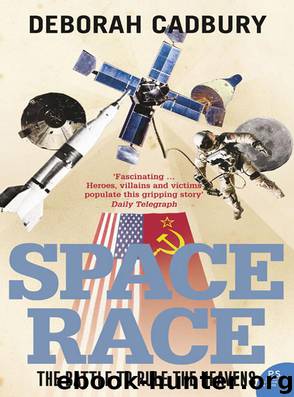Space Race by Deborah Cadbury

Author:Deborah Cadbury
Language: eng
Format: mobi, epub
ISBN: 9780007388936
Publisher: HarperCollins Publishers
Published: 0101-01-01T00:00:00+00:00
Despite the developments in the American space programme, to his great frustration Korolev still could not win the backing from the Soviet leadership for a manned space flight programme. In November 1958, he did persuade the Council of Chief Designers to approve his designs both for the Vostok capsule and a reconnaissance satellite. But just to make sure that military needs took precedence, some wit coined the phrase ‘Reconnaissance satellite is more important for the Motherland’, which infiltrated the society at Baikonur like an unwelcome echo.
New Year 1959 saw Korolev preoccupied with a fourth attempt to land an object on the moon. He was desperate for success, knowing that the Americans were trying to get there first. ‘I am nervous,’ Korolev wrote home, ‘but what can I do if all our work is a search for something new, and because of this we may have failures and misfortunes?” Korolev’s lunar craft carried scientific instruments which would determine whether the moon had a magnetic field as well as taking other measurements. The capsule held information of its country of origin – there was a heat-resistant banner spelling the letters ‘USSR’ and a small container designed to explode on impact and scatter seventy-two pieces of steel on the surface of the moon, bearing the launch date and the Soviet hammer and sickle. Korolev was sure he had the trajectory correctly calculated, but using radio to confirm the craft’s course would be difficult. He put a brain trust together to work out a solution – someone even suggested using a small nuclear bomb and measuring the time from the appearance of its flash. This was dismissed, however, as the moon had no atmosphere, and hence no dust cloud would form. Eventually, Korolev settled for a device that would create a glowing yellow cloud which astronomers could use to track the craft. To do this, a pack was devised in which napalm would ignite 2 pounds of sodium.
On 2 January, the R-7 was launched successfully and Luna 1 was the first spacecraft to leave the gravitational pull of the earth entirely, marking this victory with a colourful flag of yellow vapour seven hundred miles high as it passed over the Indian Ocean. It had been meant to crash on the moon, leaving its Soviet signature. It came within 3700 miles of its target, and then, with a failure of the control system, it fell into orbit around the sun. Although the R-7 had failed to hit the moon and leave the symbols there which would have marked the phantom Soviet presence, for Korolev the little ‘moon ship’ was a wonder. He renamed his probe Mechta – the Dream.
The mission was hailed by Khrushchev as a great accomplishment. Managing to ignore the ultimate failure of the enterprise, he could not resist boasting to the world of his Soviet ‘scientists, designers, engineers and workers who achieved a new exploit of world-wide importance, having successfully launched a multi-stage cosmic rocket in the direction of the moon …
Download
This site does not store any files on its server. We only index and link to content provided by other sites. Please contact the content providers to delete copyright contents if any and email us, we'll remove relevant links or contents immediately.
Whiskies Galore by Ian Buxton(41885)
Introduction to Aircraft Design (Cambridge Aerospace Series) by John P. Fielding(33064)
Small Unmanned Fixed-wing Aircraft Design by Andrew J. Keane Andras Sobester James P. Scanlan & András Sóbester & James P. Scanlan(32744)
Craft Beer for the Homebrewer by Michael Agnew(18146)
Turbulence by E. J. Noyes(7942)
The Complete Stick Figure Physics Tutorials by Allen Sarah(7312)
Kaplan MCAT General Chemistry Review by Kaplan(6868)
The Thirst by Nesbo Jo(6832)
Bad Blood by John Carreyrou(6558)
Modelling of Convective Heat and Mass Transfer in Rotating Flows by Igor V. Shevchuk(6392)
Learning SQL by Alan Beaulieu(6213)
Weapons of Math Destruction by Cathy O'Neil(6152)
Man-made Catastrophes and Risk Information Concealment by Dmitry Chernov & Didier Sornette(5926)
Digital Minimalism by Cal Newport;(5669)
Life 3.0: Being Human in the Age of Artificial Intelligence by Tegmark Max(5478)
iGen by Jean M. Twenge(5368)
Secrets of Antigravity Propulsion: Tesla, UFOs, and Classified Aerospace Technology by Ph.D. Paul A. Laviolette(5311)
Design of Trajectory Optimization Approach for Space Maneuver Vehicle Skip Entry Problems by Runqi Chai & Al Savvaris & Antonios Tsourdos & Senchun Chai(5012)
Pale Blue Dot by Carl Sagan(4917)
